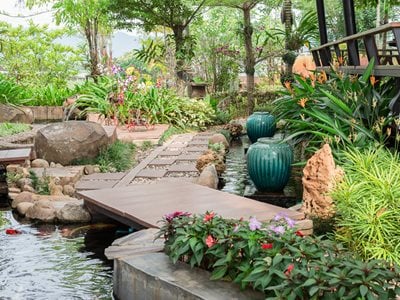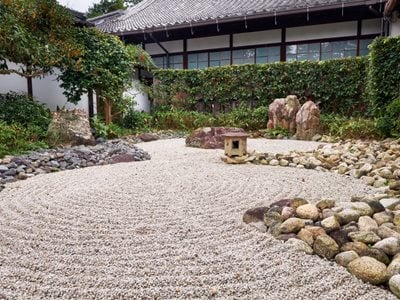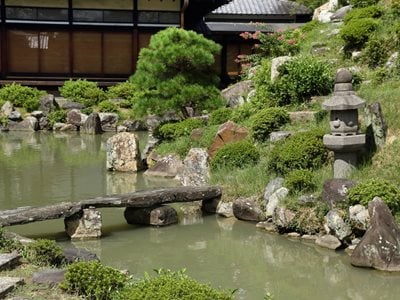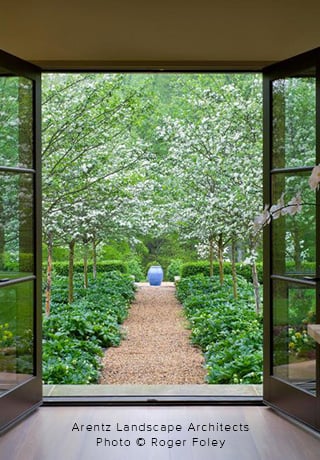Japanese Garden Ideas: Add a Touch of Japanese Style to Your Yard
Get inspired by these ideas for creating your own peaceful Japanese garden sanctuaryIf you’ve ever visited a Japanese garden, you know the feeling of calm and quiet contemplation it inspires. Based on philosophical tenets of ancient Japanese culture, these traditional gardens take cues from the natural world while incorporating a human sense of order and discipline. Elements of stone, water, plants, and manmade structures are mindfully combined to create a beautiful space for peaceful meditation.
The Japanese method of gardening, dating back hundreds of years, has evolved into different types of gardens and styles. These design principles have been incorporated into public and private gardens across the globe. Learn more on how to create your own Japanese-inspired outdoor space with some of these ideas.
WHAT IS A JAPANESE GARDEN?
A traditional Japanese garden is intended to be a place of serene beauty to connect with nature, with areas for quiet reflection and meditation. The formal disciplined style includes natural elements of rocks, stone, gravel, water, statuary, and plants. The emphasis is on form and structure rather than color. Characteristics include a limited color palette, minimalist style, and elements with deep symbolic or religious meaning. These gardens are designed to be seen from intentional vantage points, with borrowed views that connect the garden with the surrounding landscape.
TYPES OF JAPANESE GARDENS
There are different types of Japanese gardens, each with specific attributes and functions. Some of these types include:
Stroll garden (Kaiyu-shiki-teien):
This larger type of garden is comprised of a series of connecting pathways, often complemented by ponds or waterfalls. A strolling garden embraces the principles of Zen and Shinto that promote mindfulness and a connection with nature. These winding pathways are designed for leisurely walking and quiet contemplation, with disappearing views to encourage exploration and create a sense of mystery. Decorative elements include arching bridges, stone sculptures, and lanterns.
Dry landscape garden (Karesansui):
Also known as a zen garden or Japanese rock garden, this type is characterized by the use of stone and rocks, little or no water, and few plants. Rocks are carefully arranged to create mini-landscapes of streams, mountains, and islands, with some rocks representing animals or other figures. Fine gravel or sand is raked into patterns to represent rippling water. A dry landscape garden is typically enclosed by walls, fencing, or formal hedging. Find more on creating your own zen garden.
Tea garden (Roji, syn. Chaniwa):
The Japanese tea ceremony, known as chanoyu, is an integral part of traditional Japanese culture. Tea gardens represent Buddhist principles of harmony and simplicity, serving as a tranquil setting for meditation, personal reflection and appreciation for nature. There is typically an outer garden connected by a stepping stone path to an inner garden.
The teahouse is the central feature, built with natural wood and stone materials to blend with the surroundings. A rustic stone basin provides a place for washing and purifying the hands before entering the teahouse to participate in traditional rituals of tea preparation and consumption. A tea garden is typically embellished with stone lanterns, mossy ground covers, and neatly manicured plants.
Courtyard garden (Tsubo-niwa):
This compact private garden, found adjacent to Japanese homes, is designed to be viewed from indoor vantage points. Small Japanese courtyards often have windows or sliding glass doors to connect the inside to the outdoors. They typically feature miniature landscape scenes, statuary, and a small water feature or raked gravel to simulate water ripples. Due to limited sunlight and space, plants are shade-tolerant and meticulously pruned to prevent them from becoming overgrown.
Hill and pond garden (Tsukiyama):
Also known as pond and island garden, or pond garden, these miniature landscapes include artificial rolling hills and water features, representing the concepts of stability and permanence. Ponds are a prominent design component, reflecting the sky to enhance the surrounding beauty and evoke tranquility. These gardens often feature spring-blooming cherry blossoms or sakura to symbolize the fleeting beauty of life and the arrival of spring. In autumn, these gardens explode with vivid color from the turning leaves of Japanese maple and ginkgo trees.
ESSENTIAL ELEMENTS OF A JAPANESE GARDEN
Japanese gardens utilize natural and manmade features to create miniature reproductions of natural scenery or storytelling vignettes. These elements emphasize harmony and the connection between humans and nature. Some of these major elements include:
Stones, rock, gravel, and sand:
Carefully selected and placed rocks help to anchor the landscape with the natural surroundings. The shapes may symbolize islands, mountains, hills, or animals. Stones are used for pathways and structures. Flat areas of gravel or sand symbolize water, and are often raked into patterns to simulate the movement of rippling water.
Water:
Ponds, streams, waterfalls, fountains, and stone basins are prominent features throughout the landscape, evoking a feeling of tranquility and reflecting the surroundings. In Japanese culture, water symbolizes life, renewal, purity, and cleansing. Waterfalls signify the flow of time and transitory nature of life.
Bridges, pathways, and stairs:
These manmade elements connect and mark the transition between different areas. Bridges are made of wood and are typically arching to enhance visual appeal and encourage quiet contemplation. Pathways and stairs are made of gravel, stepping stones, or natural pavers. Bridges and stairs can symbolize the journey of life and the transition between the physical and spiritual worlds. Pathways represent the journey of life and exploration of nature, and are designed for mindful strolling and meditation.
Lanterns and statuary:
These features hold deep religious, spiritual and philosophical symbolism, and are considered the guardians of the garden. They are placed strategically as focal points throughout the landscape. Lanterns, which come in different shapes and sizes, are typically made of stone, metal or wood. They are considered guiding lights, representing brightness, spiritual enlightenment, and protection from evil. Made of stone, bronze, clay, plaster, or wood, statuary may represent protective spirits or important figures in Buddhist and Shinto religions.
Structures:
Manmade structures facilitate and balance the connection between humans and the natural world. These features include pagodas, teahouses, pergolas, gates, and arbors.
Screening:
Walls, fences, and hedges are used to create privacy and divide garden areas. Walls are made of concrete or stone, while fencing is most often made with bamboo. Hedges are trimmed for a formal, minimalist appearance.
Plants:
One of the characteristics of Japanese style gardens is the restrained and disciplined use of plants. The focus is on foliage and structure rather than colorful flowers. Some plants hold symbolic meaning, such as purity (cherry blossoms), longevity (pine), and resilience (ginkgo). Trees may be pruned into bonsai to represent clouds.
Plants such as cherry, wisteria, Japanese maple, and ginkgo are chosen for their seasonal beauty. Trees, shrubs, perennials, and ground covers are layered to create order and depth. Moss is a predominant ground cover, evoking a sense of tranquility and representing simplicity and refinement. See more: 20 Japanese Garden Plants
DESIGN PRINCIPLES OF JAPANESE GARDENS
Specific design principles rooted in Japanese culture and philosophy are used to guide the design and construction of Japanese gardens. These include:
Wabi-sabi:
This concept centers on imperfection and transience, with the appreciation that gardens are ever-changing, imperfect, and incomplete. It embraces simplicity and carefully selected natural elements to create a harmonious and peaceful setting. Using irregular stones and weathered materials intentionally enhances imperfections, adding character and charm, with these features becoming more beautiful with age.
Shizen:
Meaning "natural" in Japanese, this is the practice of arranging rocks, water, and plants into miniature landscapes. Though the selection and placement of materials is intentional, the goal is to create a space that feels natural, simple and spontaneous.
Fukinsei:
This is the principle of embracing asymmetry rather than the symmetrical design layout often found in Western landscapes. The goal is to avoid uniformity and create a harmonious yet balanced space with the more relaxed appearance that is found in nature.
Shakkei:
Incorporating views of the distant landscape or “borrowed scenery” to connect the surroundings to the garden. This creates a greater sense of depth and makes the garden space feel larger. Trees or manmade structures are placed strategically to frame and draw attention to distant views.
Ma:
This principle emphasizes the importance of negative space between elements, which helps create a sense of harmony and balance. The empty space draws attention to important features such as structures or rocks, and creates flow and movement. Negative space holds equal importance to the elements themselves, resulting in a whole that is greater than the sum of its parts.
HOW TO MAKE A JAPANESE GARDEN
There are many ways to incorporate Japanese garden design into your yard. Whether you want to transform your entire property into a Japanese-style garden, dedicate one area, or incorporate Japanese elements into an existing garden, consider these factors:
Choose a site:
Evaluate your yard to find the best spot for a Japanese garden. Consider light exposure, size, grade, soil, and proximity to your home. Decide on a specific type of garden or a mixture of concepts. A courtyard garden should be placed adjacent to the home, while a stroll garden might meander throughout the yard.
Get inspiration:
Look at books, online resources, and local gardens for ideas and inspiration. Make a list of the main features you want to include, such as a pond, meditation space, or pergola.
Use guiding principles:
Incorporate at least some basic Japanese design principles into your outdoor space. The more strictly you adhere to traditional design principles, the more authentic your garden will appear.
Create a design:
Draw up a sketch to visualize what your Japanese garden will look like. For more elaborate designs, consult a landscape professional that specializes in Japanese garden design.
Consider scale:
When choosing materials, consider the size of your home and property. Larger rocks may overwhelm a small space, while small stones would get lost in on a larger property. For a small yard, install a waterfall, fountain, or water basin rather than a large pond. Choose plant varieties that won’t outgrow their space.
Use natural and local materials:
To retain the natural aesthetic of a Japanese landscape, choose rustic-looking stone and rocks. Stone materials obtained from local quarries help retain a sense of regionality. Select irregular rocks and organic materials such as bamboo and wood to achieve a more natural aesthetic.
Add four-season interest:
Japanese gardens are intended to be enjoyed year-round.
- Spring: Include cherry trees, camellias, azaleas, and wisteria that bloom in spring.
- Summer: Japanese iris, lotus, and hydrangeas produce flowers in summer.
- Fall: Japanese maples, dwarf gingko, and chrysanthemums offer fall color.
- Year-round: Evergreen boxwood, bamboo, conifers, ferns, and moss provide a serene, lush look year-round.
Keep it simple:
Japanese gardens are designed with simplicity in mind. Keep the design simple and uncluttered to retain a calm and meditative feel. This is especially crucial for smaller spaces, which can easily become cluttered.
Appeal to the five senses:
Include elements for a multi-sensory experience, which helps create a calming, meditative space.
- Sight: Lanterns, statuary, bridges, and bamboo fencing act as focal points and a place for the eye to rest.
- Smell: Cherry blossoms and wisteria add a delicate fragrance to the garden in spring, while pine trees have a more pungent scent.
- Hearing: Moving water from a waterfall or fountain, bamboo rustling in a breeze, and melodic bird songs provide gentle, soothing sounds.
- Touch: Rough rocks and smooth bamboo trunks are appealing to the touch.
- Taste: Enjoy the taste of tea from a quiet seating area.
HOW TO MAINTAIN A JAPANESE GARDEN
The natural yet disciplined look of a Japanese-style landscape requires regular maintenance to keep it looking its best. Here are some tips on how to maintain your Japanese-inspired landscape.
Keep it clean:
Regularly pick up fallen leaves, branches, and other debris to keep the garden looking neat. Rinse off rocks, stones, furniture, or other elements if they become dirty or discolored.
Weed:
Keep garden areas free of weeds to avoid an unkempt look. Schedule a few minutes daily or weekly during spring and summer when there are more weeds.
Water:
Keep plants regularly watered. Make sure your irrigation system is working properly.
Prune:
Remove broken or diseased growth from trees and shrubs as it occurs. Deadhead spent flowers. Trim back overgrown ground covers away from pathways and gravel areas.
Keep it natural:
To retain a natural appearance, allow moss to grow on rocks. Fencing made of wood or bamboo can be allowed to weather for ageless appeal. Allow trees and shrubs to retain their natural shape and size.
Maintain water features:
Clean ponds, waterfalls, fountains, and basins periodically to keep water clear and fresh.
Hardscape:
Inspect stone pathways to makes sure they are stable. Repair or replace damaged elements. Rake gravel or sand to maintain patterns and keep them looking their best.
PUBLIC JAPANESE GARDENS TO VISIT
For ideas, inspiration, and an escape to nature, visit some of these popular Japanese gardens:
- Portland Japanese Garden, Portland, OR
- Japanese Tea Garden, San Francisco Botanical Garden, San Francisco, CA
- Seattle Japanese Garden, Seattle, WA
- The Huntington Library, Art Museum and Botanical Gardens, San Marino, CA
- Brooklyn Botanical Garden, Brooklyn, NY
- The Japanese Garden at the Fort Worth Botanical Garden, Fort Worth, TX
- Shofoso Japanese House, Philadelphia, PA
- Morikami Museum, Delray Beach, FL
- Elizabeth Hubert Malott Japanese Garden, Chicago, IL
- Anderson Japanese Gardens, Rockford, IL
- Meijer Gardens & Sculpture Park, Grand Rapids, MI
- Seiwa-en Japanese Garden, St. Louis, MO
SEE MORE JAPANESE-STYLE GARDENS



ABOUT THE AUTHOR
Janet Loughrey is a veteran garden writer and photographer with over 25 years of experience, contributing to major publications like Garden Design, Better Homes and Gardens, and Sunset. A former Master Gardener, she brings hands-on expertise from gardening in a wide range of climates, from upstate New York to the Pacific Northwest.
RELATED:
Zen Garden Design
8 Expert Tips for Stunning Shade Combinations
Designing With Foliage Over Flowers





